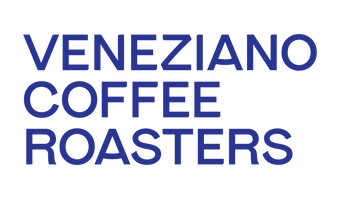By Aryan Aqajani, Veneziano Coffee Roasters Cupping Lab Assistant & Head Barista
I still remember the day I attended a public cupping session for the first time ever. I couldn’t wait to taste some amazing coffees on the table prepared by my local roaster however, I was feeling a bit embarrassed and anxious about how to “cup” the coffees and what I was meant to discover after tasting them several times. Initially I just stood in a corner watching everyone cup – I thought this would be the least embarrassing way of learning how to cup without asking to many questions or drawing too much attention to myself. They started by grinding the coffees, then setting them up on the table so that they could start the process by smelling the fragrance/aroma of the coffee. Honestly, I had no idea what the purpose was for smelling the ground coffees, nor what I should have been looking for by doing so, and this was just the beginning! To put it short, I just copied what everyone else did but still thoroughly enjoyed the whole process and the experience opened my eyes to the true complexity of coffee.
That was my first experience with coffee cuppings, and I’m sure it’s a fairly common experience. For me so far, the most challenging part has been training my palate to distinguish different flavour profiles and attributes based on the origin of the coffee. That being said, practice makes perfect as long as we expose ourselves to different coffees and taste them as often as we can.
Here at Veneziano Coffee Roasters, we cup coffee daily as a quality control measure. In the following I explain the number of reasons for cupping coffee, the fundamentals of setting up a cupping and an insight into how the scoring process works so you can replicate it anywhere, even at home.
Why do we cup coffee?
The main reason for cupping is to eliminate any brewing variables in order to accurately prepare coffees so that we can evaluate compare them on the basis of their own intrinsic merits. By brewing variables, we refer to factors such as roast degree, water temperature, brew water weight, pouring technique, grind size, brewing time etc.
The following are the key reasons why we cup coffees:
• To evaluate green coffee samples prior to purchase to ensure quality and consistency of the lot.
• To determine sensory differences between samples.
• To determine the presence of any defects.
• To determine preference between samples.
The key to a good cupping is consistency. With everything.
To ensure accuracy, the dosing of coffee and water should be precise, and perhaps one of the most important elements is consistency of timing. Set a time for each phase of the cupping and stick to it every time you cup. For instance, we break the crust every time at 4 minutes. It’s equally important to ensure the grinder being used is purged between the cups to prevent cross-contamination among coffees and that each coffee has a rinsing bowl to clean the spoon between tastings.
It’s fair to say that it takes a while to get used to these rigid cupping rules and you may make mistakes during the session however, do not get disappointed and enjoy the journey of discovering all those yummy flavours.
Basic Cupping Setup
• A table
• According to the SCAA, standard practice is to have 5 cups to cup per coffee, however we suggest two is the minimum.
• A spittoon per person. We normally use takeaway cups.
• Cupping spoons for tasting and skimming off the grounds.
• A timer.
• A grinder (preferably a flat steel burr grinder). We use a Mahlkonig EK Grinder.
• A gram scale.
• A kettle. If you have one where you can pre-set the temperature, that’s ideal.
• SCAA Cupping Form (although not quite necessary at the beginning)
Cupping Terminology
Often when we cup, we do so as a group. We also travel to origin and cup coffees with the farmers. Given there are always many and different people involved in cuppings, its important to be able to communicate and evaluate the coffees using common language scoring standards. SCAA has developed a set of cupping standards as well as a tool called a flavor wheel which is referred to when describing flavor profiles and then translating these onto the score sheet. Such descriptors range from the familiar – chocolatey, nutty, fruity – to the conceptual – clean, vibrant, creamy – to the generic – strong, weak, bitter, sweet. The following are the attributes that we look to analyse in each coffee.
• FRAGRANCE refers to aromatic aspects of dry coffee.
• AROMA is the aromatic aspect of ground coffee when infused with hot water.
• ACIDITY is the brightness and/or sourness of coffee. This can be described as the pleasing brightness or sharpness in the coffee. It is through the acidity that many of the most intriguing fruit and floral flavours are delivered, and is usually the most scrutinised characteristic of the coffee. Acidity can be intense or mild, round or sharp. Usually the acidity is best evaluated once the coffee has cooled slightly to a warm/lukewarm temperature. Many different acids are found in coffee, but some of the common ones are: Malic (commonly found in green apples), Citric (think of biting into a lemon), Acetic (vinegar), Quinic (used in tonic water, is the primary bitter compound in coffee), Phosphoric (used commonly in soft drinks, look for a sparkling sensation on your tongue),
• BODY is the mouth feel or heaviness perceived on the surface of tongue. It is useful to think about the viscosity or thickness of the coffee, and concentrate on the degree to which the coffee has a physical presence. Look for how the coffee feels on your tongue, squeeze the liquor against the roof of your mouth with your tongue. Does the weight feel closer to water or cream? Does it leave a lasting coating on your tongue? Is it smooth or slightly gritty and dry?
• FLAVOUR is the overall taste profile of the coffee.
• SWEETNESS relates to a rich, fullness in flavor, as well as any definable sweetness. The opposite in this context is sourness and astringency.
• CLEANLINESS is the transparency in the cup. It should be free of defects.
• BALANCE is how all other elements work together; no one parameter should dominate the others.
• AFTERTASTE is related to the attributes of flavour left after you have consumed or expelled the coffee. Can be either positive (lingering, sweet and clean?) or negative (dry or bitter?). A good coffee will have a clean aftertaste which supports the initial flavours and lingers for 10-15 seconds.
• OVERALL is your overall rating of this coffee taking all other elements into account.
Preparing the Cupping
1. You’ll need at least two different coffees so that you can compare them against each other. You can pick up two or more totally different coffees or very similar ones in terms of origin or processing method. It will be easier to distinguish the differences when the two cups are totally different.
2. Next, you’ll need to measure out the whole coffee beans. SCAA recommends 5.5g (+/-0.25g) per 100g of water. Determine the capacity of the cups you have selected and adjust this ratio to suit.
3. Heat the water to 95C.
4. Grind the coffee. Remember that the coffee should only be ground just before you commence cupping in order to maximize the fragrance/aroma. The grind size should be slightly coarser than a pour over grind.
The Cupping Protocol
1. Fragrance/Aroma
• Evaluate the dry fragrance of the samples
• Pour water, infuse for 3 – 5 minutes and evaluate the aroma of the wet sample
• Break the crust with your cupping spoon by drawing the spoon through 3 times, then allowing the foam to run down the back of the spoon while gently sniffing. The Fragrance/Aroma score is then marked on the basis of dry and wet evaluation.
2. Flavour, Aftertaste, Acidity, Body, and Balance
• When the sample has cooled to 71º C, which should take around 8-10 minutes from infusion, evaluation of the coffee should begin. Flavour and Aftertaste are rated at this point.
• As the coffee continues to cool (70º C to 60º C), the Acidity, Body and Balance are rated next. Balance is the assessment of how well the Flavour, Aftertaste, Acidity, and Body fit together.
3. Sweetness, Uniformity, and Cleanliness
• As the brew approaches room temperature (below 31º C) Sweetness, Uniformity, and Clean Cup are evaluated. For these attributes, the cupper makes a judgment on each individual cup.
• Evaluation of the coffee should cease when the sample reaches 21º C and the Overall score is determined by the cupper and given to the sample as “Cupper’s Points” based on ALL of the combined attributes.
Cupping etiquette
Do not shake the cupping bowls when assessing the fragrance of the dry coffee especially in public cupping sessions. If the grinds are disturbed in the bowl, the fragrance will be less intense for following cuppers making it more difficult for them to pick up on the notes.
Make sure you rinse your spoon between bowls. This ensures that you don’t carry potential defects from one bowl to the next, or flavours from a neighbouring coffee.
The louder the slurp, the better! The reason we slurp basically is to heighten the flavour notes, making them more prominent. Flavour is made up of basic taste compounds and more complex volatile components. The tongue picks up the basic compounds of, sweet, salt, bitter, acid and umami and the olfactory system picks up the more complex volatile compounds that together make up the flavours of what you taste. The olfactory receptors are located in the back of your nose and to get those complex volatile aromatic compounds back there you need to slurp the coffee as you taste. It’s daunting in the beginning, but you quickly get used to it and develop your own slurping technique.
Cupping coffee can be an enjoyable and frustrating experience at the same time. The key to become a good coffee cupper is to have patience and taste as much as coffee as you possibly can. Just like any other skill, it takes time to distinguish the flavours and pick up any defects. They say “practice makes perfect” so keep tasting different coffees and enjoy the experience. And remember, when you start cupping the most important part of the whole tasting process isn’t the scores or numbers you might apply to the coffees. Remember to take notes on what you taste, smell and experience through the whole process. Being able to verbalise and share your findings on a coffee is the first step on the way to becoming a great cupper.
Veneziano Coffee Roaster’s cupping lab will be open to the public soon. Keep on eye on social media for more information.



